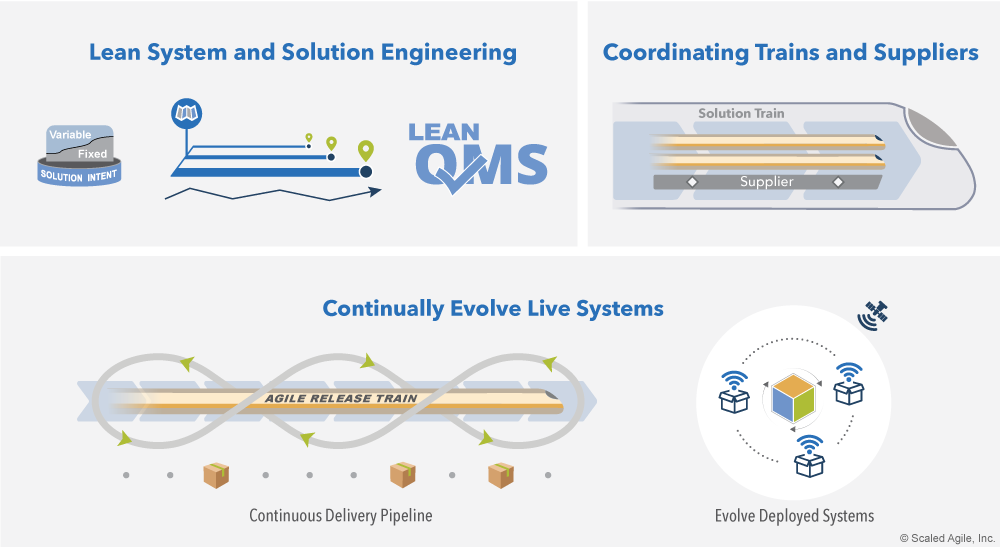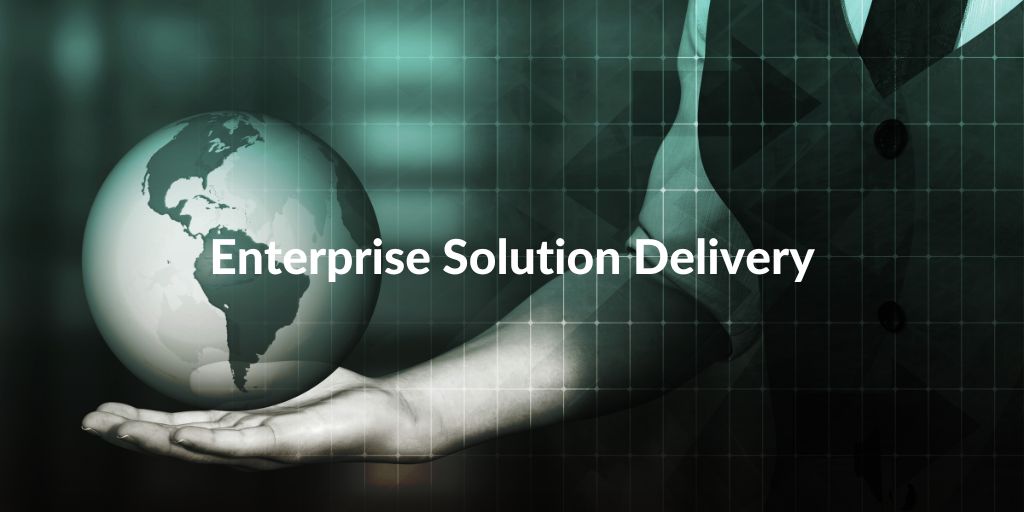The Scaled Agile Framework is a body of knowledge that includes structured guidance on values, planning and management, roles and responsibilities. The Scaled Agile Framework (SAFe) is built around the seven core competencies of the Lean Enterprise.
In this article, we will discuss the core competence: enterprise solution delivery within the SAFe framework.
The importance of adopting the Lean-Agile mindset, values and principles of SAFe
The Enterprise Solution Delivery imperative stems from the enormous effort required to build and perfect large-scale enterprise solutions. Enterprise solution systems require the involvement of hundreds or even thousands of engineers and are subject to regulatory and compliance constraints. In these large-scale software systems, complex user paths can be found across multiple products and lines of business.
In addition, cyber-physical systems require a wide range of different engineering disciplines and utilise hardware and other elements with long lead times. This complexity requires sophisticated and rigorous engineering, operations and evolution practices.
The Enterprise Solution Delivery (ESD) competence describes ten best practices for applying Lean-Agile development to build and evolve some of the world’s most important solutions. The picture below shows the three dimensions which group these ten practices.

The Ten practices for Enterprise Solution Delivery
In the field of large-scale solution development, efficiency and accuracy are crucial. The Scaled Agile Framework (SAFe) offers organisations a comprehensive framework for scaling Agile practices. At the core of SAFe are ten essential practices that play a key role in ensuring the success of business solutions.
- Specifying the solution incrementally: traditional methods often involve a lot of initial specification work, potentially delaying implementation and feedback. SAFe promotes concurrent, small-batch specification activities that enable adaptability and responsiveness. Solution managers and architects use Solution Intent, Backlog and Roadmap to ensure effective communication of requirements and design decisions.
- Apply multiple planning horizons: Agile practitioners replace rigid planning with roadmaps to manage work in a more agile manner and be able to respond more quickly to evolving requirements. This approach provides a proper separation between who is responsible for defining a long-term vision and the milestones, while allowing the teams building the solution to plan and define the details of their work.
- Design for change: architectural decisions have a significant impact on the effort and cost of future changes. SAFe enables teams to independently develop and release ‘Value Streamlets’, i.e. solution components within a larger value stream, facilitating continuous delivery.
- Frequently integrate the end-to-end solution: building the solution in smaller batches allows developers to integrate the end-to-end system more frequently. This accelerates the learning of technical assumptions about users and the market, reducing the risks associated with developing large solutions. Built-in quality practices support frequent integration between various types of components.
- Continuously address compliance issues: large solutions often incur substantial social and economic costs in the event of failure, necessitating routine regulatory oversight and compliance. SAFe supports a lean Quality Management System (QMS) that seamlessly integrates compliance activities into the value delivery process, ensuring safety and effectiveness without sacrificing speed and adaptability.
- Use Solution Trains to build large solutions: SAFe’s ARTs and Solution Trains provide proven structures and practices to align and coordinate the efforts of numerous developers and engineers. ARTs optimise alignment within teams, while Solution Trains extend this alignment to build large solutions with hundreds of developers and suppliers.
- Manage the supply chain: collaboration with internal and external suppliers is crucial to accelerate the delivery of solutions. These strategic partners must operate similar to an ART, participating in SAFe events, using backlogs and roadmaps and adapting to changes. Agile contracts foster collaboration and suppliers must align their backlogs, roadmaps and architectural paths to the overall solution.
- Build an end-to-end Continuous Delivery Pipeline: Continuous Integration is critical for continuous delivery, as it verifies changes and validates assumptions across the entire system. Although large solutions pose a challenge for continuous integration, the use of different Continuous Delivery Pipelines customised for specific types of components allows for rapid feedback and validation.
- Evolve deployed systems: recognising that solutions evolve continuously, SAFe promotes a product-based approach to development. This approach supports a development value stream that continuously delivers value to customers, accelerating time to market and simultaneously building the solution and its necessary Continuous Delivery Pipelines (CDP) infrastructure.
- Actively manage artificial intelligence/machine learning systems: AI and ML practices play an increasingly significant role in controlling behavioural logic and improving solution performance. Integrating AI/ML into large-scale solutions requires careful consideration of telemetry, data management, model design and tuning.
A comprehensive framework
Together, these ten practices form a comprehensive framework for implementing efficient and effective business solutions within the SAFe framework. By adopting these practices, organisations can address the complexities of developing large-scale solutions with precision and adaptability.
Source: Scaled Agile Framework
